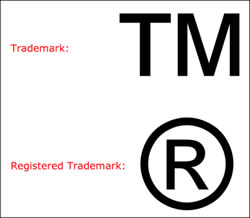Difference between Copyright and Trademark
Key difference: Copyright gives a person the ownership and rights over an original piece of work. A trademark is a recognizable sign, design or expression which is associated with a brand. Trademarks can also be just a word, a phrase, symbol, design or any combination herewith.

Copyright and Trademark are two ways of legally protecting intellectual property rights. However, they are used to protect different types of intellectual property rights and by different means.
Copyright gives a person the ownership and rights over an original piece of work. Copyright is a legal concept which provides the creator of an original piece of work with the ownership, the right to copy, right to be credited for the work, right to determine who may adapt the work to other forms, right to determine who may perform the work, right to determine who may financially benefit from it, and other related rights.
Around 165 countries in the world support the Berne Convention standards. Under these standards, the copyright is automatic. The copyright is applicable for either 50 years from the day the original piece of work has been published or 50 years after the death of the author, which ever is later. However, pieces of work can be copyrighted further by getting a valid copyright from the Copyrighting Authority, as applicable in the country.
The original piece of work may be literary, dramatic, musical, or artistic in nature. It may also include other creative works. However, the piece of work should be ‘substantive and discrete’, which means that it should be original, and should be physical in nature, not an idea. It must also show that some skill and thought was used in creating the work. One can’t just draw a line on paper and expect to copyright the “drawing”.
However, copyright does not apply to ‘intellectual property such as titles, names, short phrases, and slogans; familiar symbols or designs; or mere variations of typographic ornamentation, lettering, or coloring.’ These would be covered under trademark.
 A trademark is a recognizable sign, design or expression which is associated with a brand. Trademarks are often used to identify a particular brand, logo, or company. They often identify products or services. For example: Nike’s “swoosh” checkmark, Puma’s puma, Microsoft’s colorful window, Apple’s bitten apple, McDonalds’ golden arches or Playboy’s bunny. These logos are all trademarks of their respective companies.
A trademark is a recognizable sign, design or expression which is associated with a brand. Trademarks are often used to identify a particular brand, logo, or company. They often identify products or services. For example: Nike’s “swoosh” checkmark, Puma’s puma, Microsoft’s colorful window, Apple’s bitten apple, McDonalds’ golden arches or Playboy’s bunny. These logos are all trademarks of their respective companies.
Trademarks may also incorporate slogans, such as Nike’s “Just do it”;; Panasonic’s “Ideas for Life”; Nokia’s “Connecting people”; Volkswagen’s “Das Auto”; and McDonalds’ “I’m loving it.” These are also trademarks of their respective companies.
Trademarks can also be just a word, a phrase, symbol, design or any combination herewith. A trademark can’t be used by any other entity, as long as it is registered with the respective company, as the use of the trademark can imply that the person using the trademark is somehow linked or affiliated with the person who owns the trademark. The trademark can be owned by a company, an individual, a business organization, or any legal entity.
The main difference between a copyright and trademark is that a copyright is mainly used for creative works, whereas trademarks are generally used for logos, symbols or slogans. However, some elaborate logos, symbols or slogans may be applicable for both a copyright and a trademark.
Image Courtesy: howto.gov, klugerkaplan.com









Add new comment